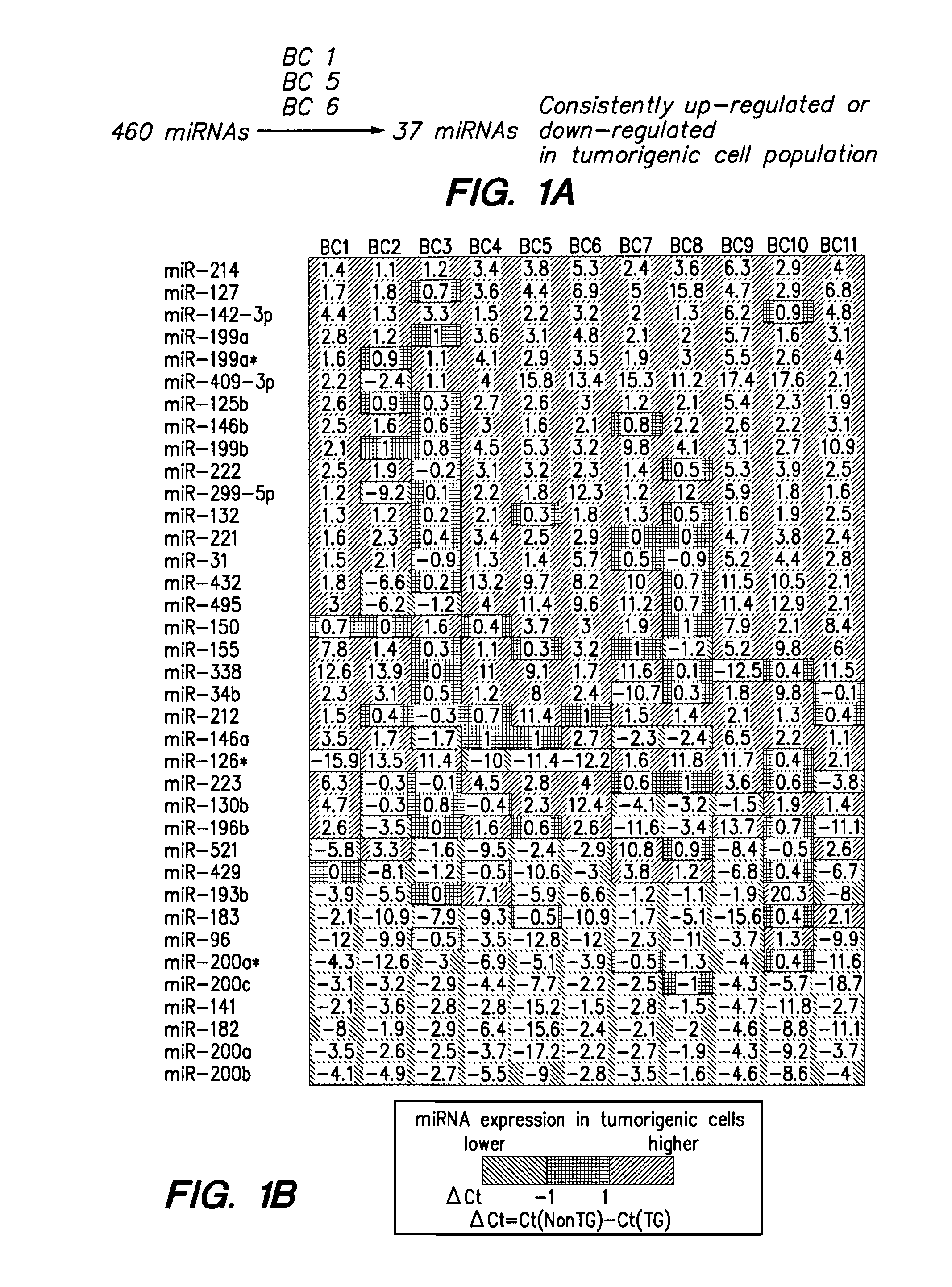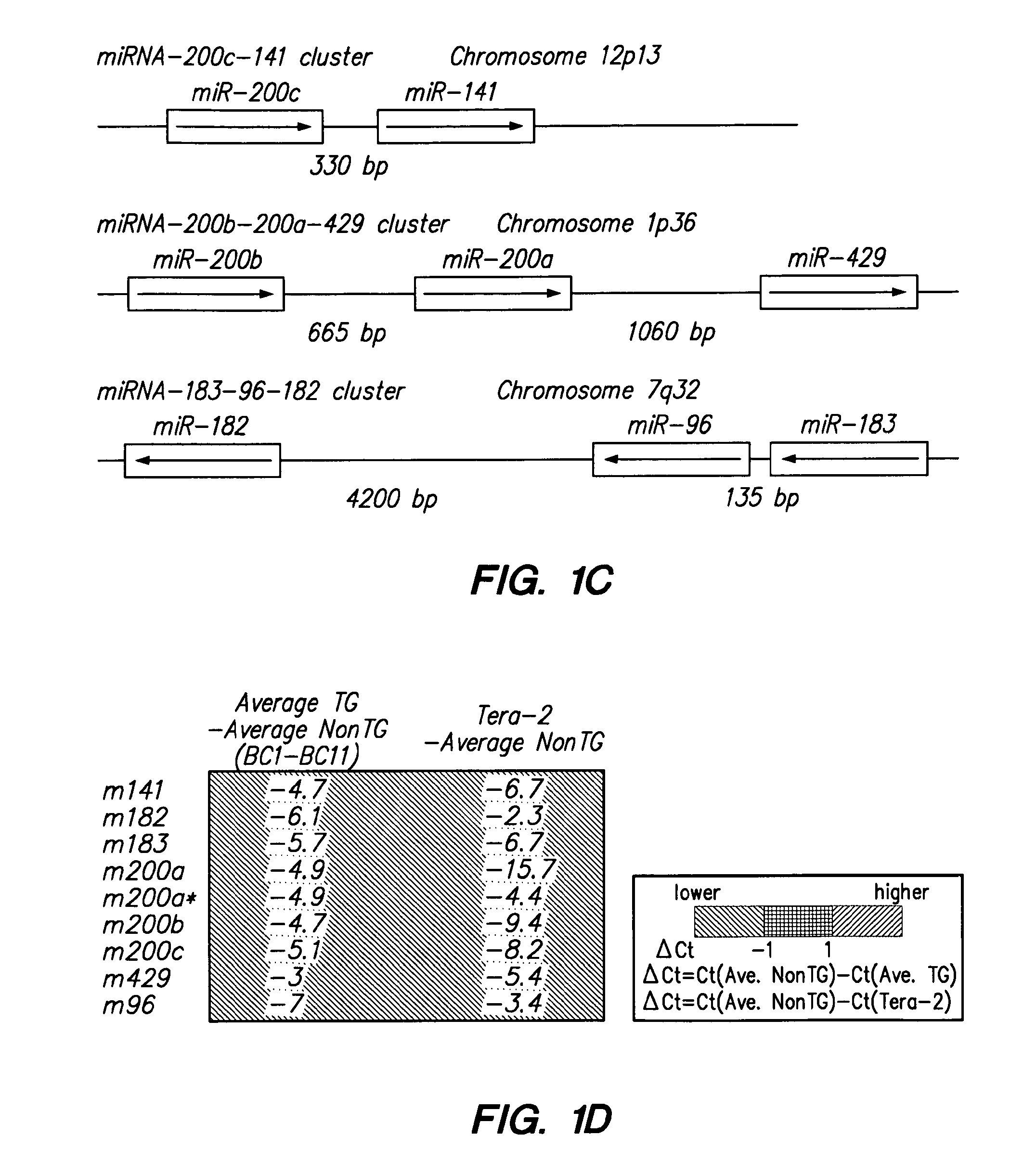Methods and Compositions Relating to Carcinoma Stem Cells
a technology of stem cells and compositions, applied in the field of methods, can solve the problems of metastatic disease, limited use of traditional therapies, radiation therapy, chemotherapy and hormonal therapy, etc., and achieve the effects of reducing expression, increasing the expression of such mirnas, and reducing the expression of their protein targets
- Summary
- Abstract
- Description
- Claims
- Application Information
AI Technical Summary
Benefits of technology
Problems solved by technology
Method used
Image
Examples
example 1
Identification of a Breast Cancer Stem Cell Gene Signature
[0138]We previously identified BCSC based on their expression of CD44 and CD24, as being CD44+CD24− / lowLineage−. Normal breast epithelial cells, defined by the cell surface marker expression, ESA+ Lineage− (CD64−, CD31−, CD140b−, CD45−), were isolated from three breast reduction samples. By microarray analysis, we looked for differentially expressed genes between BCSC isolated from 6 patients (3 primary malignant pleural effusions and 3 human breast tumors grown as solid tumor xenografts in immunodeficient mice) and normal human breast epithelial cells derived from 3 reduction mammoplasties. A set of 186 genes were selected based on a two-fold difference in expression level with a t-test P valueThe New England Journal of Medicine, 356: 217-226, 2007, herein specifically incorporated by reference).
[0139]BCSCs and non-tumorigenic cancer cells from 10 patient tumors were further screened for the expression of more than 500 miRNA...
example 2
[0144]Development of markers that can be used as prognostic and predictive tools on formalin fixed paraffin embedded (FFPE) tumor specimen. The sequences identified herein as differentially expressed in BCSC are used to generate markers (in situ hybridization probes) to determine the quantity and location of tumor stem cells in formalin-fixed, paraffin-embedded (FFPE) tissues. All breast cancer biopsies and resection specimens are analyzed by histologic examination which uses thin sections of material that has been embedded in paraffin after fixation in formalin. As such, there exists a very large collection of tumor specimens in the archives of the surgical pathology departments throughout the country that can be used for the histologic study of tumor stem cells and the role that they play in clinical outcome and response to adjuvant therapy.
[0145]Tissue microarrays (TMAs) containing Formalin Fixed Paraffin Embedded (FFPE) tumor samples with known clinical outcome are used to deter...
example 3
[0150]Target pathways that render CSCs resistant to standard cytotoxic chemotherapies. Exogenous miRNAs or synthetic shRNAs are used to target pathways that make CSCs resistant to treatment. Three different published methods are used to deliver the shRNA: liposomal delivery (see Sorensen et al. (2003) J Mol Biol 327, 761-6), conjugation of the shRNA with atellocolagen (see Takeshita et al. (2005) Proc Natl Acad Sci USA 102, 12177-82), and conjugation of the shRNA with a monoclonal antibody / protamine complex (see Song et al. (2005) Nat Biotechnol 23, 709-17). The third method utilizes an antibody that can specifically target the cancer cells. In the latter case, antibodies that specifically bind to CSCs or antibodies that target all of the cancer cells are tested. Flow cytometry is used to identify the antibodies that will target the CSCs or all of the cancer cells in a particular xenograft tumor.
[0151]Xenograft tumors established from 6 different patients' tumors are tested to deter...
PUM
| Property | Measurement | Unit |
|---|---|---|
| Composition | aaaaa | aaaaa |
| Level | aaaaa | aaaaa |
Abstract
Description
Claims
Application Information
 Login to View More
Login to View More - R&D
- Intellectual Property
- Life Sciences
- Materials
- Tech Scout
- Unparalleled Data Quality
- Higher Quality Content
- 60% Fewer Hallucinations
Browse by: Latest US Patents, China's latest patents, Technical Efficacy Thesaurus, Application Domain, Technology Topic, Popular Technical Reports.
© 2025 PatSnap. All rights reserved.Legal|Privacy policy|Modern Slavery Act Transparency Statement|Sitemap|About US| Contact US: help@patsnap.com



